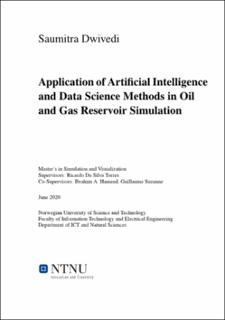| dc.description.abstract | The oil and gas industry works with a few of the most complex and challenging industrial processes across several domains of engineering. Such industrial processes usually require precision, in order to suppress the outcome error magnitude and volatility, thus ensuring effective and safe hydrocarbon production. To properly monitor and control such processes, this industry deals with vast amounts and various sources of data. For instance, it is highly important for an oil and gas company to accurately predict the oil and gas fluid flow inside the subsurface reservoir, so as to make profitable business decisions (e.g. where and how deep to drill an oil producing well or a water injection well? with which kind of well characteristics?). For this purpose, reservoir data like pressure, amounts of production fluids (oil, water and gas) are frequently monitored at the wells.
Conventionally, such oil and gas reservoir data are used to build complex and computationally expensive, physics-based numerical simulation models to account for geological heterogeneity while representing the overall reservoir fluid flow dynamics. However, these physics-based numerical models are based on several assumptions, made to simplify the mathematical representation of fluid flow physics. Moreover, being computationally intensive, the accuracy of such models is usually challenged by the limitation of computation resources. To address these challenges, this thesis aims to explore modern techniques based on artificial intelligence (AI) and data science, in order to produce data-driven workflows to analyze, model, and simulate reservoir pressure dynamics.
In particular, two independent aspects associated with reservoir engineering and simulation were studied in this thesis. Firstly, it was investigated a data-driven workflow to model reservoir pressure at any point in space and time from sparse pressure data observed at wells, without building a physics-based numerical model. This workflow was termed as spatiotemporal modelling of reservoir pressure. Secondly, a methodology was formulated to build an AI proxy model in order to produce machine-learning-based reservoir pressure simulations as a fast alternative to conventional physics-based numerical simulations.
Spatiotemporal modelling of reservoir pressure was based on a three step workflow including multivariate analysis of pressure data, pressure modelling and spatiotemporal interpolation. The overall workflow provided a comprehensive method to understand and map the reservoir fluid flow dynamics using data science tools. Several modelling techniques like generalized additive models, machine learning, spatiotemporal kriging were investigated for its applicability and accuracy as a part of this thesis. Moreover, the workflow was applied to a real oil and gas reservoir case, for which the reservoir pressure prediction accuracy was optimized through a few experiments. The optimum experiment produced highly accurate prediction with a mean absolute error of 26.85 psi. Moreover, a portion of data used was kept to evaluate blind test accuracy, which amounted to a mean absolute error of 55 psi, for the optimum case.
On the other hand, the workflow for machine-learning-based reservoir simulations was based on the idea of building a proxy model from a few sensitivity physicsbased numerical simulations, using machine learning. This AI-based proxy model was then used to simulate pressure profiles, thereby replacing the physics-based numerical simulation model. The overall applicability of this workflow was aimed towards the objective of history matching. Such machine-learning-based simulations provided a fast alternative to conventional simulations, thereby providing an opportunity to simulate several scenarios to find a better history match. This would be in contrast to the conventional practice of using gradient-based optimization methods (with fewer simulations), which usually end up providing a local optimum as a history match. Additionally, several experiments were conducted to optimize for the AI-based model characteristics, based on comparing AI-based simulations and physics-based numerical simulations. The most optimized model produced a mean absolute error of 13.37 bars. Similar to ST modelling workflow described above, the AI-based proxy model’s accuracy was also evaluated on test dataset which yielded a mean absolute error of 15.33 bars, for the most optimized experiment.
The proposed data-driven workflows were aimed to improve current methods of reservoir engineering and simulation. The suggested workflows showed high accuracy in reservoir pressure predictions and simulations with high efficiency in use of computational resources and time. Additionally, the proposed workflows were developed using open source libraries which pose no additional cost to computation, in contrast to extremely expensive industry standard physics-based reservoir simulation software. Moreover these workflows could also be used to model other reservoir properties like production ratios (Water cut, and Gas-Oil Ratio), contacts (Water-Oil contact and Gas-Oil contact), among others. | en_US |
